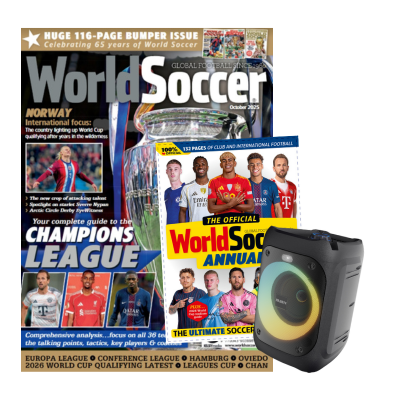Kashima Antlers have strengthened their squad as they look to retain their J.League crown.
By Mike Plastow in Japan
This season’s competition promises another fascinating race between 18 closely matched teams that tend to differ widely in terms of style. And if there is one thing the J.League continues to prove, it is that there is no single “Japanese way” of playing.
Expect more of the same from champions Kashima Antlers this season. Oswaldo De Oliveira has inherited the solid 4-4-2 approach of his Brazilian predecessors: building from the wings, extremely firm at the back and reserving a big role for the brilliance of Marquinhos in attack.
Oliveira has assembled a strong squad that includes rapidly improving youngsters such as Atsuto Uchida and Shinzo Koroki. With Mitsuo Ogasawara back from injury and Takeshi Aoki again knocking on the door of the national team, Antlers are clearly good enough to win a record third consecutive title.
Perhaps Asian Champions League success has made Gamba Osaka take their football more seriously again. Great going forward, Gamba had the league’s fourth-worst defensive record last season and are trying to remedy that this campaign by bringing in young Japan defender Kazumichi Takagi from S-Pulse and tall South Korea centre-back Park Dong-hyuk.
With South Korea’s Cho Jae-jin and Brazilian Leandro also arriving to reinforce the Gamba attack, and the midfield centred on Yasuhito Endo, this looks like a powerful recipe for success in the J.League as well as Asia.
Asian Champions in 2007, Urawa Reds remain Japan’s biggest earning, best-supported club, but last year’s seventh place was their lowest league finish since 2002. New manager Volker Finke has the difficult task of trying to reorganise a team of big-name players in a state of shock. Last year’s injury problems have at least receded, and Alex and Robson Ponte should both be ready to start the season.
Reds’ Brazil-born midfielder Tulio has had a knee operation and, along with Tatsuya Tanaka, he is back in Japan’s national team. There are no big new signings but Reds might just have enough to become the team they weren’t last season.
With Takashi Sekizuka returning to the helm after health problems, the time has surely come for last year’s runners-up Kawasaki Frontale to win something. They can strike from anywhere – with three good foreign forwards; two trigger-happy Japan midfielders, Kengo Nakamura and Hiroyuki Taniguchi; and wingers Satoru Yamagishi and Yusuke Mori – while the rearguard features two important back-up members of the national squad in defender Shuhei Terada and keeper Eiji Kawashima.
Dragan Stojkovic returned to Nagoya Grampus as manager last year and they recorded their highest finish since 1996, taking third spot. Frode Johnsen has since gone but
Davi from Consadole Sapporo is a big signing up front to play alongside Japan striker Keiji Tamada, and the arrival of Hayuma Tanaka from Marinos provides options on the wing.
Grampus midfielder Yoshizumi Ogawa, the league’s best new player last term, was a revelation in his first full year at the club and he will be one to watch out for again in this campaign.
The two extremes of Japanese football are exemplified by two young managers born just four days apart, in September, 1965. Kenta Hasegawa’s shoot-on-sight approach took Shimizu S-Pulse to the League Cup Final last year, and his attack will be even brighter now that Johnsen from Grampus and Yuichiro Nagai from Reds have joined national team striker Shinji Okazaki. The big concern is defender Takagi may be missed at the back.
Four days Hasegawa’s junior, Pericles Chamusca at Oita Trinita has devised a far more patient, pragmatic defensive style of football (and one that earned Trinita victory over S-Pulse) in the League Cup and fourth place in the league – their highest-ever finish.
Chamusca is standing by most of the squad he had last season, including veteran striker Ueslei, but he has made a sharp buy in young forward Yasuhito Morishima from Cerezo Osaka.
Vissel Kobe drew far too many matches to challenge for the title last year but some powerful new signings could put them among the leaders this time. Caio Junior takes over as manager and Japan’s two-time World Cup skipper Tsuneyasu Miyamoto arrives from Red Bull Salzburg as captain. Kazuki Ganaha from Frontale and Marcel on loan from Benfica join the attack, and the central midfield pairing of Kim Nam-il and Alan Bahia will be
as good as any. Even the loss of Japan striker Yoshito Okubo to Wolfsburg of Germany may not matter too much.
FC Tokyo should be the best of the rest. The capital’s top club stayed in contact with the leaders from start to finish last season and achieved their highest league finish since 2003 in sixth. Look out also for Omiya Ardija, where South Korea’s Park Won-jae and Croatia’s Mato Neretljak have strengthened the defence.
Yokohama F.Marinos, Kashiwa Reysol and Albirex Niigata have made few changes and all three may find it hard to break out from the lower half of the table. JEF Chiba could climb a few places on the strength of last season’s form after Scottish coach Alex Miller took over, while Kyoto Sanga have consolidated with some good foreign signings.
Jubilo Iwata, on the other hand, have made no big changes after narrowly missing relegation last season. After winning the second division championship, Sanfrecce Hiroshima have decided to carry on with the same team. The downside is that it still looks very like the team that was relegated in 2007. Montedio Yamagata, promoted in second place, have something of a journeyman squad with everything still to prove.
Key Dates
Season starts: March 7, 2009
Mid-season break: May 25, 2009 to June 19, 2009
Season ends: December 5, 2009
J.League Cup Final: November 3, 2009






